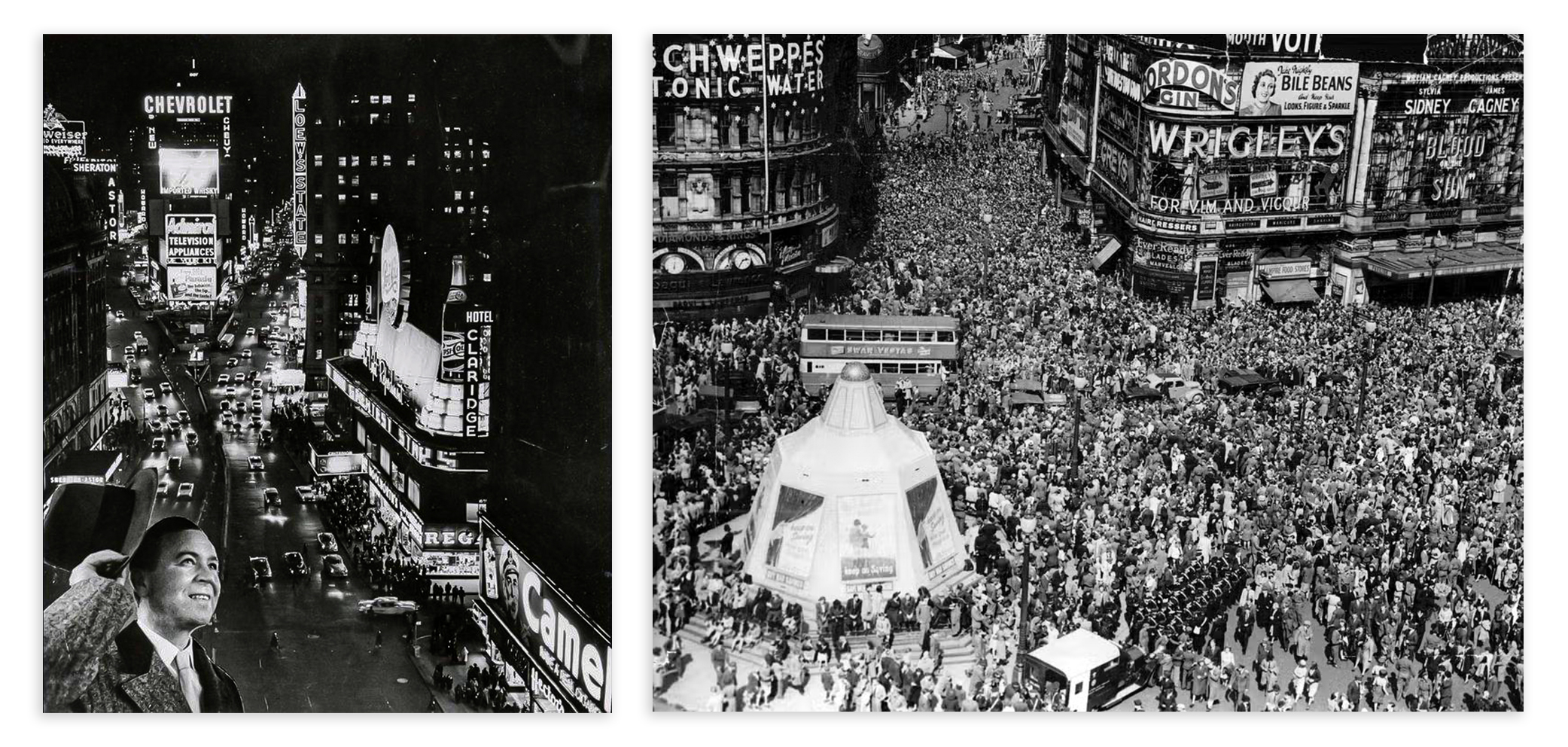
OUTSITE Brings You The History of OOH in 15 Amazing Milestones
Sponsored by ![]() OUTSITE OOH
OUTSITE OOH

It is well known among marketers that OOH is the oldest advertising medium, but perhaps you don’t know how old it actually is! From messages carved on stones thousands of years ago to the brightest LED billboard in NYC Times Square today, here are 15 milestones in the history of Outdoor Advertising that will amaze you:
Ancient Civilizations: obelisks and carved stones
1. The oldest type of outdoor advertising is a 5,000-year-old tableau recently discovered in the ancient Egyptian city of Elkab. 50cm-tall hieroglyphic script was chiseled onto the stone, apparently to announce the ruling family's power to travelers and passersby. Obelisks and carved stones were commonly placed at crossroads to inform travelers of territorial laws.

Hieroglyphics tableau from 3,200BC recently discovered by Yale University professor John Coleman Darnell
Likewise, outdoor signs were common practice in other ancient civilizations, like Greece and Rome, where sellers would paint or carve messages on the sides of buildings or large rocks near main roads.
Middle-Ages: first printed posters
2. Fast forward to the 1450s, when German goldsmith Johannes Gutenberg invents movable type printing. Printed leaflets, called handbills, become very popular across Europe and are mainly used to advertise theater plays and town fairs – and because they were usually handed out to be hung on posts, today we call them “posters”.
 Handbill for Barnes and Finley's booth, Smithfield Fair, 1701
Handbill for Barnes and Finley's booth, Smithfield Fair, 1701
Parallel to city posters posted signs on the roads are used to advertise inns for travelers, though they’re more informative than marketing-oriented.
18th century: illustrated posters
3. In 1796, German actor and playwright Alois Senefelder invents stone printing, soon to be known as “lithography”. Although originally meant to print maps and musical scores, it gave birth to the first major form of outdoor advertising: the illustrated poster. Thanks to this new printing technique, business owners can now create colorful advertisements for their storefronts to promote their products and services.
19th century: large-format billboards
4. In the 1830s, Jared Bell creates the first large, colorful posters in America. Considered to be the precursor of the billboards as we know them today, the posters were 7 or 8 feet large and mostly advertised traveling circus shows.

5. By the 1860s, outdoor spaces for rent started to proliferate, and pioneer media owners offer companies the opportunity to promote their products and services with hand-painted billboards of varied formats and sizes.
6. In 1889, American company Morgan Litho presents its 24-sheet billboard at the Paris Exposition, and then again at the 1893 World’s Columbian Exposition in Chicago. This format soon became the most popular advertising billboard and the first standardized one.
20th century: cars and neon signs
7. At the Paris Expo of 1910, French engineer George Claude unveils his red neon tube lamp. By 1912, Parisian boulevards are illuminated with the “liquid fire” neon signs of several local businesses, and in 1913 Cinzano installs its brand name with 3.5ft neon letters on top of a building on Haussmann Boulevard.

8. With the boom of motor vehicles in the 1920s mobility becomes a trend, and advertising billboards start to proliferate on the roads. In the USA, the industry grows so big so fast that by the 1960s the American government is forced to pass a law to prevent OOH ads from blocking the scenery by the roadside.
9. Meanwhile in urban centers, lighted signs and billboards start to boom. In 1937, advertising genius Douglas Leigh introduces the first animated electric sign in New York Times Square, a set of 2,000 light bulbs that displayed a cavorting horse and ball-tossing cats. Despite the slowdown brought about by WWII, by 1948 Leigh had populated the facades of Times Square buildings with bright signs and billboards that were truly spectacular.

10. In 1964, JC Decaux installs the first bus shelter in Lyon, France. Monsieur Decaux travels around France lobbying local authorities to adopt this new concept of street furniture, suddenly creating a new advertising medium with massive reach.
11. Back in America, Leigh installed the first full-color animated billboard on the front facade of the Times Tower in 1976: a 20 by 40 feet illuminated panel using George Stonbley’s invention “Spectacolor”. With more than 8,000 bulbs, the electronic sign displayed text, graphics, and video.
12. In the 1980s, the industry sees the rise of media buyers, and advertising professionals specialized in dealing between media owners and agencies, giving shape to the OOH market as we know it today.
13. By the end of the 1990s, LED display boards began to appear and slowly start to replace traditional billboard signs.
21st century: omnipresent digitalization
14. In the first decade of the 2000s, fast-developing digital technology becomes the standard across all industries, and Outdoor advertising splits into two markets: one that keeps selling traditional OOH in all its formats and sizes, and a new market that is opening up to sell digital billboards and large-format screens – DOOH, or Digital Out of Home.
15. The 2010s have witnessed incredible advances thanks to digitalization: location intelligence, interactive screens, mobile sensor technology, hyper-realistic graphics, and ultra-high-definition ad displays.

Outdoor advertising has proven to be the most resilient and creative of all marketing channels throughout millennia and stood still, nowadays D/OOH amazes people everywhere with the latest naked-eye 3D, another spectacular technique. Stay tuned to our Experts Talk section to learn more about this amazing medium and be the first to witness the next milestone!
This is an exclusive free resource for our community
Download Now!
Come on, tell us what you feel about this article.






_cover.jpg)

